The Curious Case Of Running Backs Returning
The deadline for players to declare for the 2020 NFL Draft expired on Monday. Despite a record number of underclassmen declarations, there has been several high-profile eligible players opting to return to college. The decisions of Chuba Hubbard, Najee Harris, and Kylin Hill had been of great interest and intrigue. Then followed the shock decision of Travis Etienne to return to Clemson for 2020. Against an overall trend, why are these running backs returning to school?
Life is good 🇨🇦 pic.twitter.com/EIIpkJoAgl
— Chuba Hubbard (@Hubbard_RMN) January 13, 2020
There can be no doubt that there is a growing trend for players to forego their remaining College Football eligibility. Despite a down year in 2015, the number of underclassmen declaring for the NFL Draft is higher than it’s ever been. The 2014 NFL Draft had a record, at the time, 98 underclassmen declare. Since then, we’ve seen figures in the 90s for 2016 and 2017, before the bar was raised again in 2018 with 106 underclassmen declaring. Last year, 103 players jumped ship from the college game to pursue their dream of playing in the NFL. This year the record has been smashed again, with 115 players forgoing their senior year of eligibility.
Who can blame them?
As much as the college game brings entertainment, passion, and adoration, it does not bring money. Hopefully the NCAA will act swiftly to right that wrong, but currently college football players do not make a penny from a game that earns programs and television millions of dollars. So, the lure of the NFL and the financial stability it brings, is of course overwhelming.
However, this year it feels like more big names than ever are going back to school for another bite at the college football cherry.
Convention goes against running backs returning
Of all the positions in football, the running back position is one where its deemed vitally important to make the most of your NFL opportunity.
It is literally a rush to get to the league.
The average lifespan of an NFL running back is just 3.3 years. This is due to a combination of susceptibility to injury and the impression that running back value can be found anywhere, anytime. Why pay a running back a second contract when you can bring in a rookie once you’ve had your use out of a player.
We’ve seen this already in the NFL with the protracted contract negotiations with players like Le’Veon Bell, Ezekiel Elliott, and Melvin Gordon.
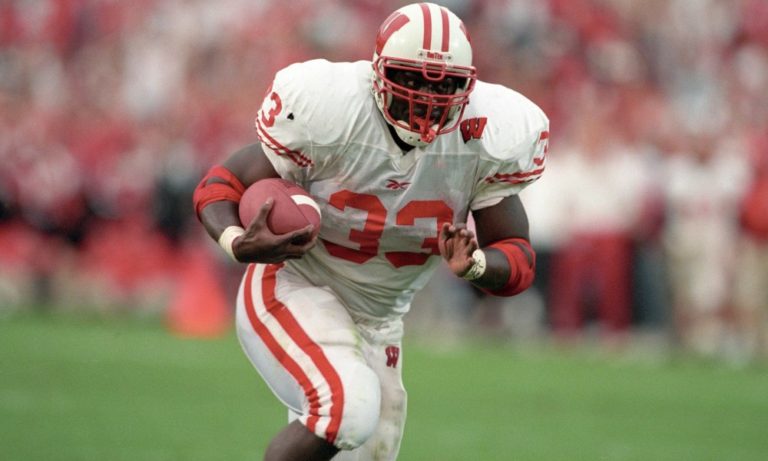
Putting as little mileage on your body, whilst impressing on the field and the stats charts, and then making the transition to the NFL is the perfect route.
Despite Jonathan Taylor being a dominant force for three years at Wisconsin, already his value is being questioned due to his 926 carries in three years as a Badger.
The top 10 leaders by college football career carries, have an average of 5 years for the NFL careers. This is dramatically bolstered by Hall of Fame running back, Tony Dorsett who had 11 successful seasons with the Dallas Cowboys and Denver Broncos.
Despite these facts, the leading rusher in the country, Chuba Hubbard and Travis Etienne lead a cast of running backs returning to college action in 2020.
Why?
Potential reasons for running backs returning
They have turned their back on an NFL Draft running back class that could have been one of the greatest of all time. There are multiple backs that could easily be first round picks, if there were enough teams in desperate need of a running back.
D’Andre Swift and J.K. Dobbins will likely duke it out for the first running back taken. Jonathan Taylor despite the concerns is still worthy of a first-round grade.
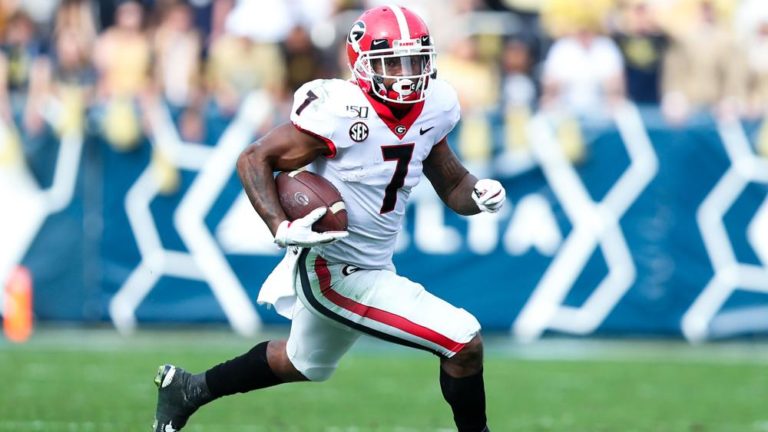
That’s four running backs before you even get to the likes of FSU’s Cam Akers, Boston College’s A.J. Dillon, Eno Benjamin of ASU, and National Champion running back Clyde Edwards-Helaire.
Then factor in players that were in the Top 20 rushing yard leader, such as Malcolm Perry from Navy or Lynn Bowden Jr from Kentucky who aren’t running backs by trade but could easily transition to that position in the NFL.
It’s a rich well in which NFL teams can dig.
By not declaring for the NFL Draft this time, Etienne, Hubbard, Harris, and other running backs returning to school are putting themselves at the top of the running back class for the 2021 NFL Draft.
Of course, it has inherent risk. If you suffer an injury or loss of form next year then your draft stock may take a pounding.
However, the pay day difference between being a first-round pick or second/third-round pick is so vast that it’s obviously worth taking that risk. Especially when you consider that, over the last four NFL Draft’s, between 29% (2019) and 35% (2018) of all underclassmen went undrafted.
Who will be College Football's top running backs in 2020?
The running backs returning to school will obviously be must-watch during the 2020 college football season. With one eye on that and the other on the 2021 NFL Draft who are set to be the top running backs in 2020?
Travis Etienne - Clemson
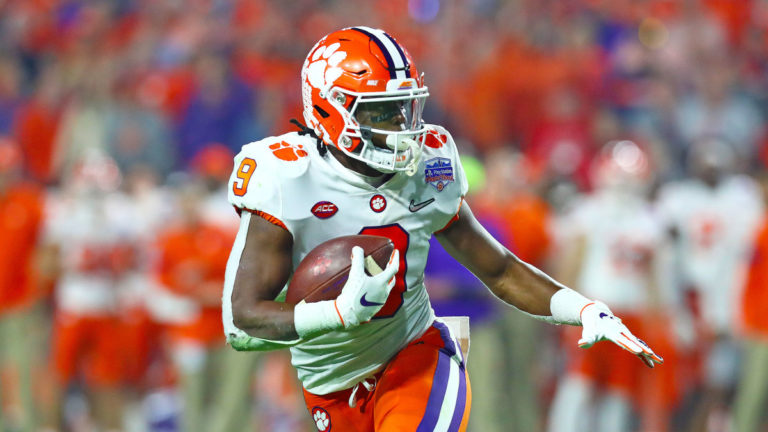
Travis Etienne was firmly in the RB1 conversation for the 2020 NFL Draft before his surprise decision to return to Clemson for the 2020 College Football season.
Unless soething goes dramatically wrong for Etienne in 2020, he will already be the favourite to be the first running back taken in an increasingly strong 2021 NFL Draft class.
Etienne has all the tools to succeed as a modern day running back. He has power, speed, and is arguably one of the best catch passing running backs in all of football. In 2019 he had 432 receiving yards on 37 catches, with four touchdowns for good measure.
Etienne has back to back 1600+ yard seasons. He ground out an impressive 7.8 yards per carry, second in the nation behind Lynn Bowden Jr. When Trevor Lawrence had some early season troubles, it was Etienne that Clemson leaned on to grind out results.
After defeat in the National Championship to LSU, Etienne returns to Clemson hungry to deliver another title to the Tigers.
Chuba Hubbard - Oklahoma State
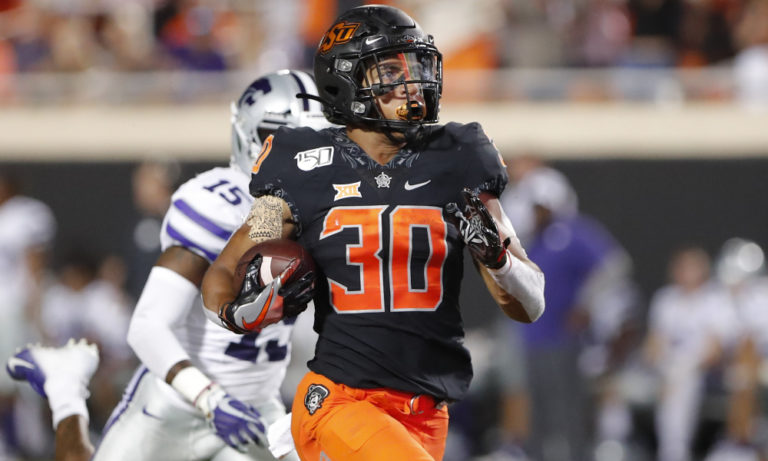
Where better to start than the guy who led the entire nation in rushing yards in 2019? Chuba Hubbard’s return to Oklahoma State is probably the most surprising of all the running backs returning in 2020.
Alongside fellow returnee, Tylan Wallace, and second year starter Spencer Sanders, there is a little bit of offensive momentum building in Stillwater. Are the Cowboys a sneaky outsider for the BIG 12 title in 2020?
If Hubbard can replicate his 2019 performance, then they’ve every opportunity.
Not only did Hubbard lead the league in rushing yards (2094), he did so at an impressive 6.38 yards per carry. His 21 rushing touchdowns were tied for second most in the FBS.
He achieved all of this without a running back stablemate to provide a distraction for opposition defenses. No other back on the Cowboys 2019 roster had more than 40 carries. Their second leading rusher was quarterback Sanders.
The opposition knew it would be Hubbard running the rock but still couldn’t bottle him up. Once he was out in the open-field he was uncatchable with his track speed.
Expect to see more of the same in 2020.
Najee Harris - Alabama
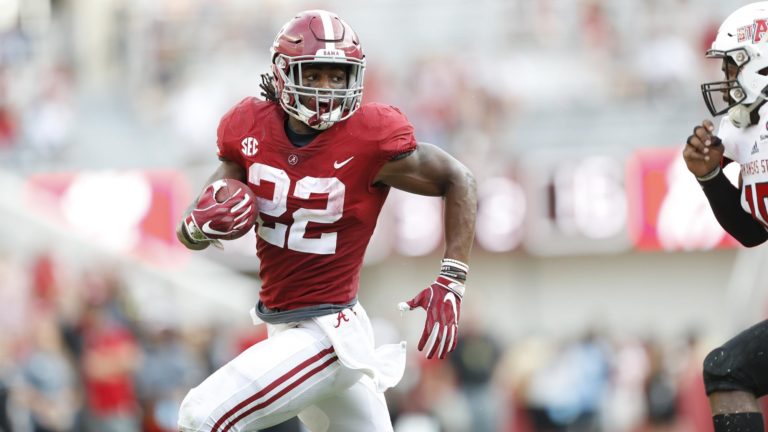
There was an expectation that Alabama head coach, Nick Saban, would give it everything he had to ensure that his underclassmen returned to school. After losing the National Championship to Clemson in 2018, and missing the College Football Playoff entirely in 2019, Saban has the hook of avenging those perceived failures in 2020 to lure players back.
Despite this, there was a feeling that Najee Harris would still declare. As such, his return his as big a surprise as any of the returning running backs.
Harris broke the Alabama running back mould in 2019.
The Crimson Tide often rotate multiple backs in their system, keeping them fresh for the inevitable College Football Playoffs appearance. Harris himself had seen this first-hand, being third in the 2018 rotation despite leading the team with 6.7 yards per carry.
In 2019 however, Harris carried that ball 209 times on his way to 1224 yards and 13 touchdowns. He showed the importance of versatility in the running back position by adding 304 receiving yards and seven touchdowns. Harris had twice the carries of second running back, Brian Robinson Jr.
It’s impossible to envision that Saban persuaded Harris to return in 2020 without a similar role.
Alabama will be angry after the perceived failure of 2019. Who better to lead them than a man who runs with the strength and anger on every play.
Josh Johnson - University of Louisiana-Monroe
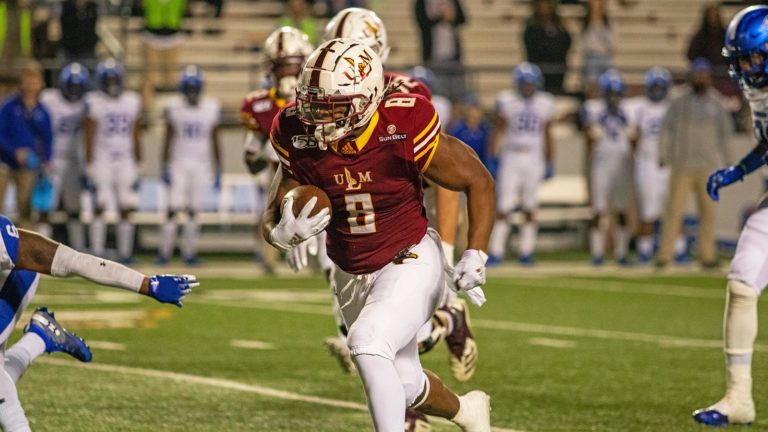
It isn’t just high-profile running backs returning to College Football in 2020 that are set to make a difference.
With far less media coverage and overall fanfare, Josh Johnson announced his return to the ULM Warhawks with a simple understated tweet on the 27th December.
1 more ULM…
Johnson is a running back gem buried in a disappointing 5-7 season for the Warhawks in 2019.
He crept in to the top 20 rushing yards leaders, his 1298 yards good enough for 19th on an offense that was the 26th best rushing team in the nation, averaging 207.3 yards per game.
What’s truly impressive is Johnson’s average yards per carry. With 6.46 YPC, he was ranked in the top 10 rushing leader by yards per carry. Three of the players in front of him were rushing quarterbacks who carried the ball far loss than Johnson’s 201 carries.
At 215lbs, in a 5’9 frame, Johnson has the build to shake off contact, combined with the upper body strength to stiff arm with the best of them.
He also has shifty feet with the ability to make men miss as evidenced in games against Georgia State and Grambling State this season.
If you’re looking for an under the radar NFL Draft prospect to watch in 2020, then the Sun Belt may be the place to find him.
Javian Hawkins - Louisville
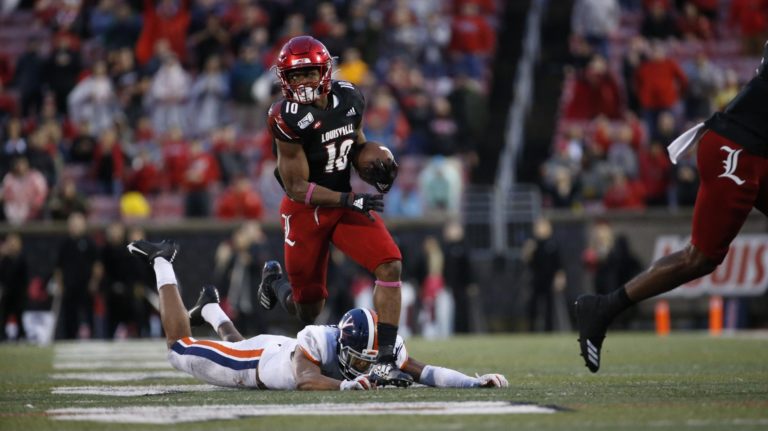
Louisville’s turn around from a dismal 2018 where they went 2-10, to a winning season and a win over SEC Mississippi State in the Music City Bowl, was one of the feel-good stories of 2019. Head coach Scott Satterfield received the ACC Head Coach of the Year as recognition for his role in the turnaround.
Some of that recognition should fall on Javian Hawkins.
Although he wasn’t eligible for the 2020 NFL Draft, and doesn’t class as a running back returning to the program instead of heading to the NFL, Hawkins contribution to 2019 should act as a springboard to even more success in 2020.
With 1525 rushing yards, Hawkins was a top 10 running back on an offense that was ranked 24th in rushing yardage. Compare that to 2018, where the Cardinals were in the bottom ten for overall offense and defense and you get a true sense of the achievement in Louisville this season.
Despite having future NFL MVP, Lamar Jackson, break 1500 rushing yards twice from the quarterback position, Hawkins became the first Louisville running back to accomplish the feat.
His performances in 2019 earned him a place on the FWAA All-American Freshman first team.
With a reported 4.37 in the 40-yard dash, Hawkins combines speed and elusiveness to good effect. He also has surprising strength for his size, churning out yards when bottled up in traffic.
Allegedly, Vegas bookmakers are already taking bets on Hawkins as a long-shot Heisman hopeful.
That may be a little premature, but he’s certainly set to be one of the nation’s top backs in 2020.
Kennedy Brooks - Oklahoma
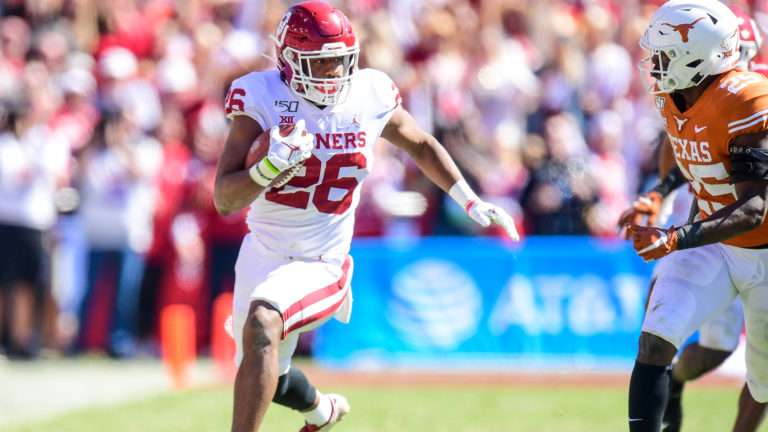
The Oklahoma Sooners offense is more commonly known for Lincoln Riley’s ability to take a transfer quarterback and turn him in to a Heisman contender. It has worked two out of the last three years and for large swathes of 2019, Jalen Hurts looked like he would make it three in a row.
As the Sooners go in to 2020 with uncertainty at the quarterback position, Brooks announcement that he would join the group of running backs returning will be welcome news in Norman, Oklahoma.
Don’t underestimate the importance of Kennedy Brooks to the Oklahoma offense.
After redshirting his freshman season with a shoulder injury, Brooks burst on to the scene in 2018. He now has consecutive 1000+ yard seasons for the Sooners. In 2019 he was in the top 10 running backs by yards per carry. Over his Oklahoma career he is averaging 7.5 YPC, better than any running back to don the crimson and cream. He heads up some illustrious company.
Injuries came back to haunt Brooks in 2019. He suffered a nasty hit early in the season against Texas Tech, and then looked to be seriously hurt in the BIG 12 title game against Baylor.
If he can come through spring and summer camps 100% healthy, then there’s no reason to expect anything other than a career year for Kennedy Brooks on his way to the 2021 NFL Draft.

OLIVER HODGKINSON
COLLEGE FOOTBALL WRITER
OLIVER HODGKINSON IS A COLLEGE FOOTBALL WRITER FOR THE TOUCHDOWN. HE ALSO WRITES ON THE NFL FOR THE PRO FOOTBALL NETWORK. YOU CAN HEAR HIS OPINIONS ON ALL THINGS COLLEGE FOOTBALL AS ONE THIRD OF THE COLLEGE CHAPS PODCAST.
